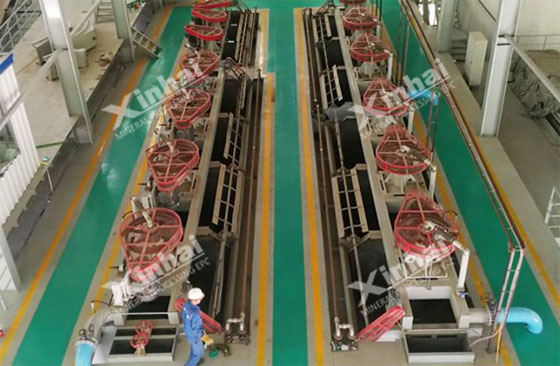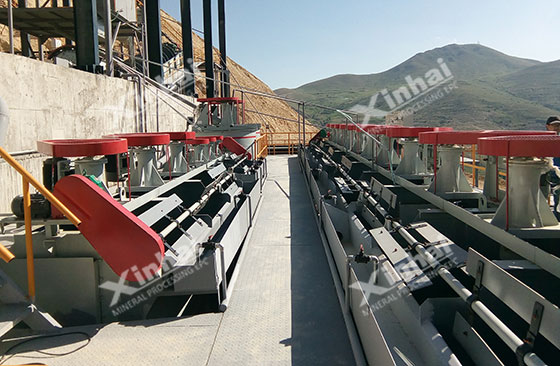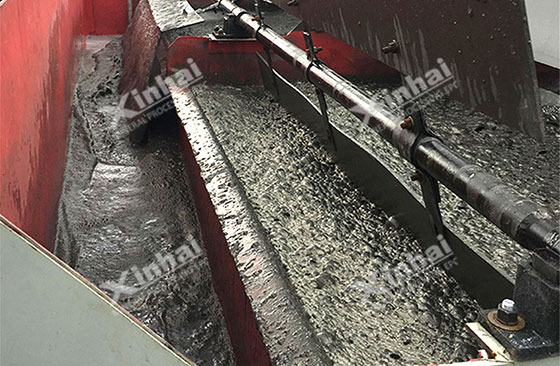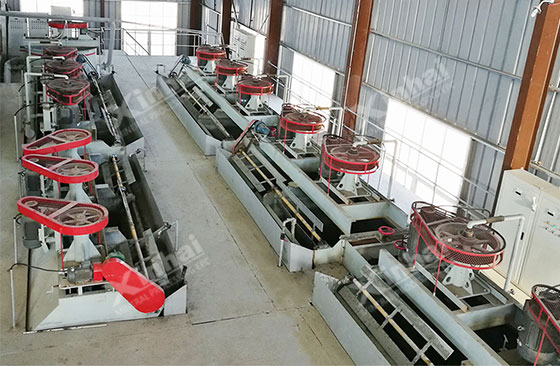
Froth flotation process is a kind of mineral processing technology that uses the flotation reagents to separate the ore according to the physical and chemical properties of the surface of the ore. The froth flotation process is to grind the mineral to the floating requirement, adjust the pulp concentration and add the flotation reagents, then inflate the air to make the mineralized froth separate.
What are the common froth flotation processes? Do you know the application condition of the froth flotation process?
The preferential froth flotation process refers to float a kind of mineral first and inhibit another kind of mineral when the polymetallic mineral contains two or more kinds of useful components, and then activate and float other kinds of mineral. This process that recycles the useful minerals in turn is the preferential froth flotation process.
Applicable condition:
Generally, the preferential froth flotation process is applied to the mineral that the useful minerals have coarse disseminated grain size, the content of useful minerals in the ore is higher or the floatability of various useful minerals is different but the content is similar.
Characteristics:
The process condition of the preferential froth flotation process is easy to control, the production index is high and stable. However, compared with the bulk froth flotation process, the preferential froth flotation process has a longer flotation time, and needs a large number of flotation cells. Besides, the grinding requirements in the early flotation are high, which increases the grinding cost. In addition, the amount of inhibitors and activators in the preferential froth flotation is large, so the production cost is higher.

The bulk froth flotation process is to separate the various useful minerals together when the ore contains two or more kinds of mineral, and then separated one after another.
Applicable condition:
Bulk froth flotation process can be used for polymetallic ore with a lower grade or the useful mineral is assembled as the aggregate. For example, when the wolframite and scheelite exist in the form of symbiotic ore, the paragenic ore has a lower grade, and the useful minerals have a close symbiotic relationship, the bulk froth flotation process is mostly adopted.
Characteristics:
Under the coarse grinding, a large amount of gangues can be discarded after the flotation in the bulk froth flotation process, which reduces the amount of gangue entering the subsequent operations and the cost of subsequent grinding operations. However, there are collectors on the surface of mixed concentrates and the excess collector remains on the slurry, which increases the difficulty of the next separation operation.

The bulk-preferential froth flotation process is a new froth flotation method based on preferential froth flotation and bulk froth flotation. It is to float some kinds of useful minerals, and inhibit other minerals, then activate and float those inhibited other useful minerals, and float the mixed concentrates again.
Applicable condition:
In general, there are several useful minerals with similar flotability in the ore, or the flotability is different. For example, when the ore contains copper-molybdenum, copper-lead, copper-zinc, lead-zinc mineral and one of them has a low grade, partial bulk-preferential froth flotation process is usually adopted.
The flotation order of iso-flotability flotation process is not completely divided according to the types of mineral. According to the same or similar floatability of the mineral, the recovered mineral is divided into easy-to-float and difficult-to-float parts, and then float them from easiness to difficulty.
Applicable condition:
Iso-flotability flotation process is suitable for treating the complex polymetallic sulfide ores with easy-to-float and difficult-to-float parts. For example, in a sulfide ore, the useful minerals are galena, sphalerite and pyrite, among which, sphalerite has two kinds of minerals which are easy to float and difficult to float, so the iso-flotability flotation process can be used.
Characteristics:
Compared with the bulk froth flotation process, the amount of reagent used in the iso-flotability flotation process is less, which not only eliminates the influence of excess reagent on the flotation, but also improves the separation index. However, the equipment used in the iso-flotability flotation process is larger than the bulk froth flotation process.

Asynchronous flotation process is a new type of flotation process that developed based on iso-flotability flotation process, which is determined by the difference of ore properties and the product requirements.
Applicable condition:
The asynchronous flotation process is suitable for the flotation of the ore that has the majority of lead and less sulfur. For example: In a lead ore concentrator, the lead is the main carrier mineral of silver, the fine lead can be separated first without inhibitor, then the fine lead-silver and coarse lead-silver, which can ensure the higher recovery rate of lead and silver.
Flash flotation process is a process that adds the single-trough flotation in the grinding circuit. Before the conventional flotation process, the flash flotation process can be used to pre-float a part of qualified concentrate, which reduces the loss caused by overgrinding of useful minerals. In other words, the useful minerals that have been liberated in the grinding circuit are quickly floated as the concentrate, which avoids them from re-entering the grinding circuit and produce overgrinding mud.
Applicable condition:
Flash flotation process is mainly suitable for non-ferrous metal sulfide ore containing metals with uneven disseminated grain size.
Characteristics:
The flash flotation process can separate the liberated coarse useful mineral in advance, thus reducing the overgrinding of useful minerals, and reducing the loss of useful minerals in the slime, improving the recovery rate of the useful minerals.

The instant flotation process is to separate the part of minerals with fast flotation speed first in a short flotation time according to the different particles of the target mineral, especially the difference of the flotation speed between the liberated mineral and the concomitant mineral.
Applicable condition:
The instant flotation process is especially suitable for the ore with uneven disseminated grain size and the coarse concentrate or medium ore need to be reground.
Characteristics:
The route into concentrate can be shortened, which realizes early and fast recovery.
Above are seven flotation processes. In the mineral process technologies, the flotation process is difficult and complicated, so please carry on the ore dressing experiment to customized the suitable flotation process.
To find out more about our products and solutions, please fill out the form below and one of our experts will get back to you shortly.